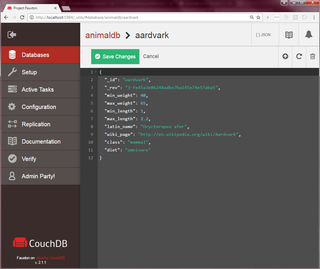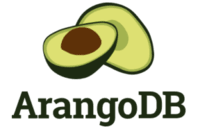In computing, a solution stack or software stack is a set of software subsystems or components needed to create a complete platform such that no additional software is needed to support applications. Applications are said to "run on" or "run on top of" the resulting platform.
A spatial database is a general-purpose database that has been enhanced to include spatial data that represents objects defined in a geometric space, along with tools for querying and analyzing such data.

Apache CouchDB is an open-source document-oriented NoSQL database, implemented in Erlang.
A document-oriented database, or document store, is a computer program and data storage system designed for storing, retrieving and managing document-oriented information, also known as semi-structured data.
HBase is an open-source non-relational distributed database modeled after Google's Bigtable and written in Java. It is developed as part of Apache Software Foundation's Apache Hadoop project and runs on top of HDFS or Alluxio, providing Bigtable-like capabilities for Hadoop. That is, it provides a fault-tolerant way of storing large quantities of sparse data.
NoSQL is an approach to database design that focuses on providing a mechanism for storage and retrieval of data that is modeled in means other than the tabular relations used in relational databases. Instead of the typical tabular structure of a relational database, NoSQL databases house data within one data structure. Since this non-relational database design does not require a schema, it offers rapid scalability to manage large and typically unstructured data sets. NoSQL systems are also sometimes called "Not only SQL" to emphasize that they may support SQL-like query languages or sit alongside SQL databases in polyglot-persistent architectures.
A graph database (GDB) is a database that uses graph structures for semantic queries with nodes, edges, and properties to represent and store data. A key concept of the system is the graph. The graph relates the data items in the store to a collection of nodes and edges, the edges representing the relationships between the nodes. The relationships allow data in the store to be linked together directly and, in many cases, retrieved with one operation. Graph databases hold the relationships between data as a priority. Querying relationships is fast because they are perpetually stored in the database. Relationships can be intuitively visualized using graph databases, making them useful for heavily inter-connected data.
Structured storage is computer storage for structured data, often in the form of a distributed database. Computer software formally known as structured storage systems include Apache Cassandra, Google's Bigtable and Apache HBase.
FlockDB was an open-source distributed, fault-tolerant graph database for managing wide but shallow network graphs. It was initially used by Twitter to store relationships between users, e.g. followings and favorites. FlockDB differs from other graph databases, e.g. Neo4j in that it was not designed for multi-hop graph traversal but rather for rapid set operations, not unlike the primary use-case for Redis sets. FlockDB was posted on GitHub shortly after Twitter released its Gizzard framework, which it used to query the FlockDB distributed datastore. The database is licensed under the Apache License.

OrientDB is an open source NoSQL database management system written in Java. It is a Multi-model database, supporting graph, document and object models, the relationships are managed as in graph databases with direct connections between records. It supports schema-less, schema-full and schema-mixed modes. It has a strong security profiling system based on users and roles and supports querying with Gremlin along with SQL extended for graph traversal. OrientDB uses several indexing mechanisms based on B-tree and Extendible hashing, the last one is known as "hash index". Each record has Surrogate key which indicates the position of the record on disk. Links between records (edges) are stored either as the record's position stored directly inside of the referrer or as B-tree of record positions, that serves as a container of RIDs, which allows fast traversal of one-to-many relationships and fast addition/removal of new links. OrientDB is the 6th most popular graph database according to the DB-Engines graph database ranking, as of January 2024.

Apache Drill is an open-source software framework that supports data-intensive distributed applications for interactive analysis of large-scale datasets. Built chiefly by contributions from developers from MapR, Drill is inspired by Google's Dremel system. Drill is an Apache top-level project. Tom Shiran is the founder of the Apache Drill Project. It was designated an Apache Software Foundation top-level project in December 2016.
DataStax, Inc. is a real-time data for AI company based in Santa Clara, California. Its product Astra DB is a cloud database-as-a-service based on Apache Cassandra. DataStax also offers DataStax Enterprise (DSE), an on-premises database built on Apache Cassandra, and Astra Streaming, a messaging and event streaming cloud service based on Apache Pulsar. As of June 2022, the company has roughly 800 customers distributed in over 50 countries.

Apache Spark is an open-source unified analytics engine for large-scale data processing. Spark provides an interface for programming clusters with implicit data parallelism and fault tolerance. Originally developed at the University of California, Berkeley's AMPLab, the Spark codebase was later donated to the Apache Software Foundation, which has maintained it since.
A wide-column store is a column-oriented DBMS and therefore a special type of NoSQL database. It uses tables, rows, and columns, but unlike a relational database, the names and format of the columns can vary from row to row in the same table. A wide-column store can be interpreted as a two-dimensional key–value store. Google's Bigtable is one of the prototypical examples of a wide-column store.

ArangoDB is a graph database system developed by ArangoDB Inc. ArangoDB is a multi-model database system since it supports three data models with one database core and a unified query language AQL. AQL is mainly a declarative language and allows the combination of different data access patterns in a single query.
RocksDB is a high performance embedded database for key-value data. It is a fork of Google's LevelDB optimized to exploit multi-core processors (CPUs), and make efficient use of fast storage, such as solid-state drives (SSD), for input/output (I/O) bound workloads. It is based on a log-structured merge-tree data structure. It is written in C++ and provides official language bindings for C++, C, and Java. Many third-party language bindings exist. RocksDB is free and open-source software, released originally under a BSD 3-clause license. However, in July 2017 the project was migrated to a dual license of both Apache 2.0 and GPLv2 license. This change helped its adoption in Apache Software Foundation's projects after blacklist of the previous BSD+Patents license clause.

JanusGraph is an open source, distributed graph database under The Linux Foundation. JanusGraph is available under the Apache License 2.0. The project is supported by IBM, Google, Hortonworks and Grakn Labs.
TerminusDB is an open source knowledge graph and document store. It is used to build versioned data products. It is a native revision control database that is architecturally similar to Git. It is listed on DB-Engines.

Ontotext GraphDB is a graph database and knowledge discovery tool compliant with RDF and SPARQL and available as a high-availability cluster. Ontotext GraphDB is used in various European research projects.